Breakfast is usually proclaimed to be the most important meal of the day. Why is it then that most of us mindlessly reach for a box of sugary cereal in the grocery aisle, rather than make our own?
I enjoy eating cereal. Not the lighter-than-air sugar-laden, or marshmallow bestowed fluff in a box, but quality, wholesome, cereal grains. You know, the kind of cereal you actually have to chew?
To have more control over the foods we eat, we already make our own bread, we produce our own eggs, and grow our own fruits and vegetables. Not wanting to purchase cereals though, lately I’ve mostly resorted to skipping breakfast altogether.
Although we don’t have the room to grow our own grains here, a variety of organic grains are readily available at most natural foods markets, often in bulk, and through some online retail vendors.
Homemade organic cereals can not only be a more economical alternative to the overpriced, prepared cereals, but they afford the opportunity to control what ends up in the cereal bowl. Whether you’re trying to avoid corn syrup, GMOs, or artificial flavors and preservatives, or you simply want a breakfast option that’s more satisfying with more flavor, it’s really not difficult to make your own.
Muesli vs. Granola – What’s the Difference?
Growing up in Europe, Muesli was a popular morning staple, and I remember my parents routinely making enormous batches of it from scratch. Muesli was invented by Swiss nutritionist Maximilian Bircher-Benner in the late 1800s, although today I mostly find it with some of the highest-priced cereals on the grocery store shelf.
There’s nothing mystical about muesli. Muesli is a simple raw cereal, traditionally made without the addition of refined sugars, or added fats. That doesn’t mean muesli is fat-free, as the grains and nuts do contain natural levels of the healthier mono- and polyunsaturated fats. Muesli is an excellent source of B-complex vitamins, and iron, and the dried fruits are a good source of antioxidants.
Muesli is usually more fruit-dense than granola, but without the added sugar, it is generally a little less sweet. Of the two muesli is also the easiest to make, as it simply requires mixing a few raw ingredients in a bowl. Even if you’re challenged in the kitchen, making your own muesli couldn’t be more simple, as there’s little to no cooking required!
I think of the Muesli recipes as having two parts. The grain base, and the additions – the fruit and nuts.
For the first part, the grain base, you can use any combination of grains you wish. For this recipe you want 4lbs total of grains.
You can mix and match them any way you wish. This recipe uses oats, barley, rye, and wheat, and has a wonderfully complex, nutty flavor.
The second part is the fruit and nut mixture. Essentially you want 3 lbs of dried fruit, and 1 1/2 lbs of unsalted nuts, and/or seeds. Try adding hazelnuts, flax seeds, sesame, pumpkin, or sunflower seeds.
This recipe is simply the version I made yesterday, but with imagination, no two batches of muesli need ever be the same.
Basic Muesli
Prep Time: 15-20 Minutes
Yield: 60 Servings – 1/2 cup per serving
1 lb Rye Flakes
1 lb Barley Flakes
1 lb Rolled Wheat Flakes
1 lb Rolled Oats (old-fashioned preferred)
1 lb 10 oz Raisins
6 oz Apricots, chopped
1 lb Whole Dates, chopped
3/4 lb Sliced almonds, toasted
3/4 lb Whole almonds, rough chopped
Equipment:
Large Mixing Bowl
Large Kitchen Knife, or Food Processor
Storage containers or zip-top bags
Mix the cereal grains together in a large bowl.
For added flavor, lightly toast the sliced almonds in a large dry skillet, until just golden.
Add the sliced and chopped almonds to the grain mixture.
Chop the dates with a sharp knife, or alternatively, pulse the whole dates in a food processor.
Chop the apricots into small pieces, and add the dates, apricots and raisins to the grain mixture, and mix thoroughly.
I find it easier to mix large batches of muesli with my hands.
The muesli can be stored in an airtight container for up to 3 months.
Serve with cold milk, or hot if you prefer, or sprinkle over yogurt, and enjoy!
Maple-Cinnamon Granola
In America granola seems to be the more favored homemade cereal choice, however, as you can tell from the list of ingredients below, granola is clearly the less healthy option.
You’re still getting whole grains, nuts and fruit, but the addition of sugar, maple syrup, and butter, means it’s not something I’d choose to eat every day. Generally speaking you can expect granola to have twice the calories, and at least twice the fat of muesli that’s made from similar base ingredients.
However, granola can still be part of a healthy breakfast, consumed occasionally, and in moderation. I’d still rather eat this, than ready-made granola. The only problem is, this particular granola made the kitchen smell so divine while it was baking yesterday, and the flavor and texture are so superior to anything you can buy, that it’s going to seriously tax my own level of discipline, and self-control, for the next few weeks. If you can bake this without stealing a few clusters directly from the oven, you’re stronger-willed than I am.
Prep Time: 2 Hours 30 Minutes – including baking
Yield: Approximately 40 servings – 1/2 cup per serving
7-1/2 Cups Old-fashioned Rolled Oats
1-1/2 Cups Sliced Almonds
1-1/2 Cups Pecans, rough chopped
1 Cup Shredded Coconut (optional)
1-1/2 Tsp Ground Cinnamon
3/4 Tsp Fresh Ground Nutmeg
1 Cup Maple Syrup*
1/2 Tsp Salt
24 Tbsp Unsalted Butter (3 Sticks)
1 Cup Light Brown Sugar, firmly packed
2 Tsp Pure Vanilla Extract
1-1/2 Tbsp Orange Zest (approx. 1 large orange)
1 Cup Raisins
1 Cup Chopped Dates
1 Cup Dehydrated Apple Pieces
Equipment:
Large Mixing Bowl
Large Kitchen Knife, or Food Processor
Medium Saucepan
2 Half-sheet baking sheets with rim
Parchment Paper
Spray Cooking Oil
Storage containers or zip-top bags
Preheat Oven: 250 F
*Tip: Grade B maple syrup is darker, and richer in flavor, than Grade A syrup. Grade B is also usually a little cheaper, and honestly, I prefer the more robust flavor.
Line two baking sheets with parchment paper, and mist the edges of the pan with spray oil to prevent the granola from sticking.
To make the granola, mix the oats, almonds, pecans, coconut, cinnamon, and nutmeg in a large bowl.
In a medium saucepan heat the maple syrup, butter, sugar and salt over medium-low heat, stirring until the butter and sugar have dissolved.
Remove from the heat and stir in the vanilla extract, and orange zest.
Pour the syrup mixture over the grain mix, and stir until the grains are evenly coated.
Divide the mixture evenly between the two prepared baking sheets.
Using the back of a spoon or spatula, press the mixture lightly, and evenly across the sheets.
Bake the granola at 250 F for a total of two hours.
After the first hour, swap the pans, and rotate them, to ensure even baking. Gently stir once, half way through baking, and lightly press the granola back down onto the sheets. Do NOT over stir, or the granola won’t have those crunchy clusters that everyone loves.
After 2 hours, remove the granola from the oven, and allow the trays to cool, undisturbed.
While the granola cools, prepare the fruit. You can use any combination of dried fruit you wish. I used raisins, dates, and apples, but you could also try dried cherries, figs, blueberries, or apricots, providing the total volume of fruit is about 3 dry cups.
Once the granola is cool, transfer it to a large mixing bowl, and gently mix in the fruit. Again, don’t over-mix, or the granola will break apart.
Store in an airtight container in the pantry for up to 3 months…although I doubt it will last that long.
Serve with milk, sprinkled over yogurt, ice cream, or simply out of hand as a snack.
If you’re used to eating puffed O’s or extruded flakes, the serving sizes may seem puny, however, when you eat a bowl of whole grains in their minimally processed form, a one-half cup serving is much more satisfying, and delicious!
With all the muesli and granola I made yesterday, I have a hunch I won’t be skipping breakfast again anytime soon!

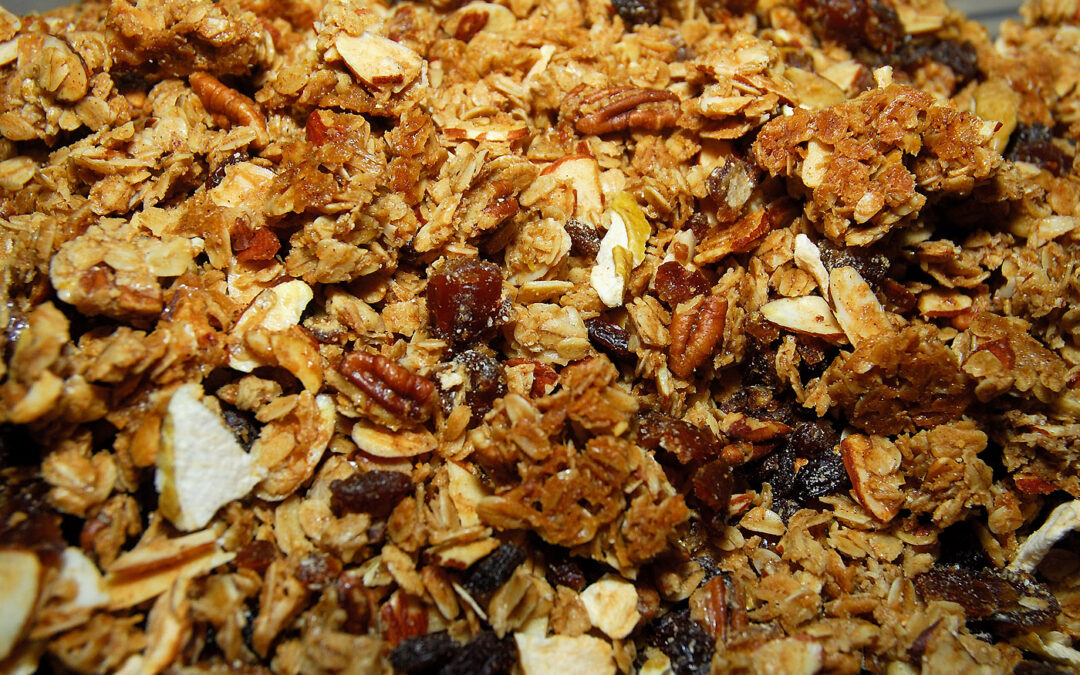
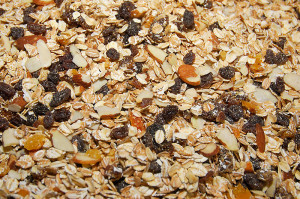




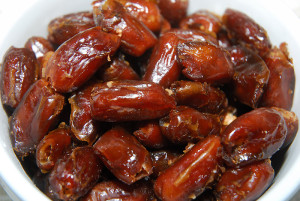



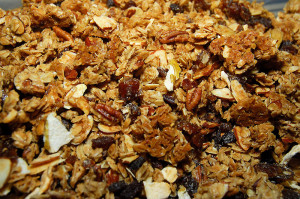


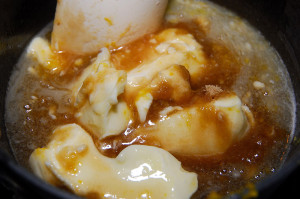
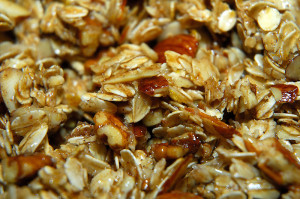
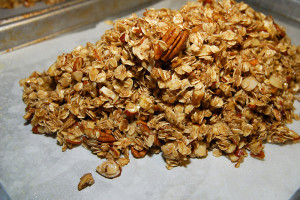
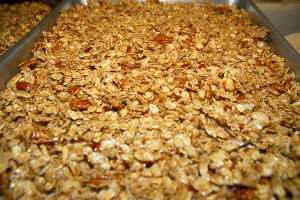
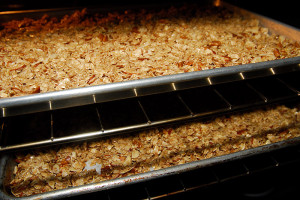
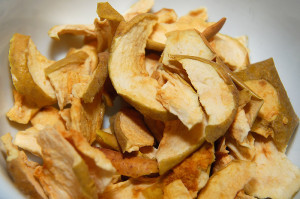
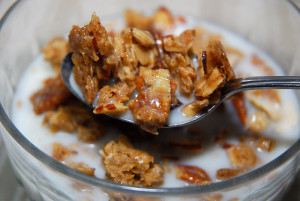







Clare I have never had muesli but it sounds and looks delicious.
I really enjoy it, especially that it’s so versatile, and that you can blend a cereal with only the ingredients you like 🙂
Mmmm. I always have breakfast and tend to favor odd combinations like fruit and yogurt with dried garbanzos and pomegranate seeds. But Mr. Mouse is a granola kind of guy and I make a granola with fairly little oil, some honey, and lots of nuts. Not as yummy as yours, but a good compromise – let me know if you want the recipe.
I like honey-based granola too, although I’m bit stingy with our honey in baked goods (I’d rather it as is). I must admit, dried garbanzo beans is not something I would have thought of!
Hi Clare,
Sounds yummy…. Mmmmmm I’d love some breakfast right about now!
I only tend to have breakfast at the weekend – can’t eat really early and my options are very narrow as I’m intolerant to milk and don’t have Rice milk in often enough. So cereal is a rarity for me.
I have a hard time eating early too, I think that’s part of why I tend to skip breakfast. I pay for it later in the day though, so I’m trying to develop better breakfast habits 😉
We are between batches of muesli, and grumbling about eating commercial granola. What I make, does the low GI thing, and keeps us going till lunchtime. Next week I’ll be back to my familiar recipe – a compromise between your two. At first I made granola, but it’s such a pain to wash up after (we didn’t have the parchment or the cooking spray, trying to keep it low fat with just a little olive oil). Now I just lightly roast the oats with spices and carob. Then add sunflower seeds, coconut flakes, and lots of nuts (halved brazils, almonds …) and dried fruit (cranberries, chopped apricots …) Each batch a little different.
Sorry, forgot the CommentLuv process
The parchment really does make clean-up a snap. Although I also think the maple syrup in this recipe makes it less prone to sticking to the pan, unlike some of the honey based granola. If you cut the parchment to fit perfectly, which I did not, you could probably skip the tiny amount of spray oil on the pan altogether. I do prefer the texture of the oil/butter granola though. Take away too much oil, and the sugars alone aren’t quite enough to hold it together. Still tasty though 🙂
It’s breakfast time here and this is so very timely! so I’ve been making granola for years, but I’ve never made muesli. I get a rolled five grain mix that would work well for it, since it has oats, barley, rye, wheat and triticale in mostly equal proportions. I usually heat the mix with water and milk like I would oatmeal, but I also use it for granola so I know it would make some great muesli. I will give this a try ASAP – thanks for sharing!
I hope you like the Muesli! I haven’t been using Triticale, primarily because I can’t find a reliable organic source for it locally. As it’s a hybrid between wheat and rye, it should taste just fine in a muesli or granola blend though. I have been able to source organic buckwheat though, and might try adding some of that in my next batch!
Yum! You have me hungry for breakfast already–and it’s 11 p.m.! Now I can’t wait until tomorrow!
I don’t usually eat that late. However, I have been known to eat cereal for lunch, or dinner, though 😉
I was brought up on Alpen………though nowadays I like the unsweetened one……though it’s so expensive here too. I’m a shredded wheat person just now (you’ll remember that too Clare) and I can remember my grandpa used to break open a raw egg and put it on top of it. Wish I was at Curbstone for breakfast………..yours looks far more appetizing than my shredded wheat.
I remember Alpen. I expect that was the inspiration for my parents blending their own. Cost. I remember the boxes were always small, and it was one of the most expensive cereals on the shelf. My parents were quite frugal though, and quickly realized that they could save a fortune making their own, and the silly thing is it’s absurdly easy to make! I haven’t shredded wheat in ages…I’m sure about the raw egg though 😉
Thanks for the muesli recipe. I might try this to save myself the baking time I usually have with granola. I make granola every few weeks here. I find storebought is very expensive and generally lacks decent ingredients. (I like some fresh ground flax in mine among other things) I was surprised to see your granola recipe contained butter and sugar. I can see why you prefer the unsweetened muesli. I add either a cup of honey or REAL maple syrup, one cup of sunflower oil and half a cup of water to my granola mixture and bake. It’s just enough to get the grains to stick together and add a touch of sweetness.
Well, with the butter and sugar, it’s certainly not a lite-granola 😛 However, I tend toward the attitude of if you’re going to eat something you enjoy, go ahead, and enjoy it…just in moderation. I honestly don’t eat the granola very often though, preferring to stick with the muesli, but I rarely make either one of them the same way twice. That’s what I love about recipes like this, you can make them your own!
I just made granola the other day. The recipe contained no butter but used olive oil, rolled oats, pepitas, dried cherries, and honey. It was the best I have ever had but disappeared in two days so I won’t be making it again soon. I didn’t use parchment paper and when it said let cool I left it on the pan. It turned to rock—it was actually quite comical—but fortunately popping it back in the oven made it come right off. You don’t need the paper if you scrape it into a bowl as soon as it comes out of the oven and you still get the chunks.
I should try making a batch with an oil like olive oil some time. Granola always needs a little fat, to be a true granola, but at least the olive oil is mostly monounsaturated fat 😉 If my granola gets stuck though, I’ll try the reheating trick. Although the parchment worked like a charm, but I always have some on hand for some of the breads I bake anyway.
Looks like a ‘must try’ recipe. I just recently published a Granola recipe on my blog. It’s funny how different recipes for the same thing can vary soooo much. Mine had one unusual ingredient I had never tried before; rice syrup. It also called for pomegranate kernel oil– I didn’t even try to find that at the grocery store!!
I’ll have to stop by and try your recipe. Most recipes call for sugar, so I liked the maple syrup version, and the granola was still crispy. I expect rice syrup or agave works just fine too. I don’t think I’ve ever seen Pomegranate kernel oil though! 😉